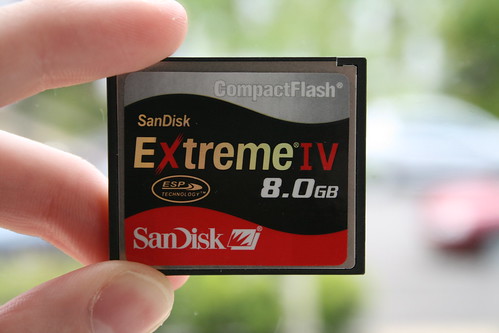Unfortunately (or not) this is not a perfect world, and there are other points to check about memory cards you get.
Size
Size is one of them. Nowadays cards go from 2GB to 32GB, more or less. What you need to do first is check the size of the pictures you take. If your camera handles RAW format, ask yourself what you want to get: JPEG files only, RAW files only, or JPEG + RAW (if available). Also do you want to take full size pictures? After that, when you know the size each picture will take on the card, you can work out the number of pictures you can fit on a card. This is what matters after all.Also to take into account: do you carry a computer or another hardware you can unload your card on? Do you mind swapping cards (how often)?
If you listen to marketing, size is the only feature that should be taken into consideration. Yes, marketing has its way to make us focus on things and hide the rest of the picture from us. Choice would be simple to make if we lived in marketing world right? Well the bad news is we don't live in this wonderland.
Speed
Speed is as important as size. When you see the size of the pictures you take, and have an idea of storage speeds, you have reasons to worry about speed! For example, I shoot in RAW+JPEG, my RAW files are about 20MB each and JPEG about 6-8MB (or more). That's 25-30MB per shot. When I move files from a disk to another on my computer, I'm happy to reach 20MB/s. With the same speed it would take more than a second to write a picture on my card; and you will not reach that writing speed. Imagine you take 5 pictures in a row. Now we've got a problem! Don't worry, your camera has a cache, data is written there first (it's much faster) and when the camera has time the photos are written on your card.We talk about card speed, actually it is card speeds: reading speed and writing speed. They are not the same. It is much faster to read than to write (if you find this weird, think about how fast you read a line of text and how fast you write it).
Reading speed is mainly important when you want to transfer your photos to another storage (your computer, an external hard drive, etc.). If your card is really slow, you will also feel it when you browse your pictures from your camera.
Writing speed is crucial while taking photos. You don't want to miss a shot because your camera is saying "wait will I write on your card". It is even more important if you use continuous shooting mode.
As speed is not the main marketing argument, it varies a lot between two cards. To make this information more readable, "classes" have been introduced, most of the time you find class 2, class 4 and class 6 cards. Again, your need will depend on the size of your photos and how you use your camera. I personnally choose only class 6 cards. But even among cards in the same class, important differences can be found. If you are looking for the best hardware, you should definitely read reviews (see end of article).
Budget
I wish I could forget about this point sometimes. But very few of us can. Quality has a price, sad but true. The good news is with internet there is a lot of competition, so don't buy too fast, check prices everywhere before buying.Compatibility
Last but not least, check if the card you want to get is compatible with your camera. This sounds obvious I know, but be sure before buying, you don't want a bad surprise. With SD cards for example, you can have three cards which look exactly the same, but one is SD, another is SDHC (SD 2.0) and the third is SDXC. While a device that reads SDXC will read a SD card, the opposite is not (always) true.Which to choose
Most of the time you decide (vote?) a budget, check what you can get with it, higher your budget because you want something better and buy. Here I would advise the opposite. This element is very important so you should first decide what is best to get, then look for the lowest price for this product. Also you can ask yourself if you should get one card of a given size or two cards of smaller size. In any case it is still good to have a backup card.To make a choice, it can be very helpful to read reviews such as:
- 13 SDHC Memory Cards Reviewed on Tom's hardware
- Roundup: CompactFlash Cards For Professionals on Tom's hardware
- High Performance CompactFlash Benchmarks on Canon 1D Mark IV on Slash Gear
- CF/SD Performance Database on Rob Galbraith
Note: I did not get paid by Sandisk for the choice of photos!
version française


No comments:
Post a Comment